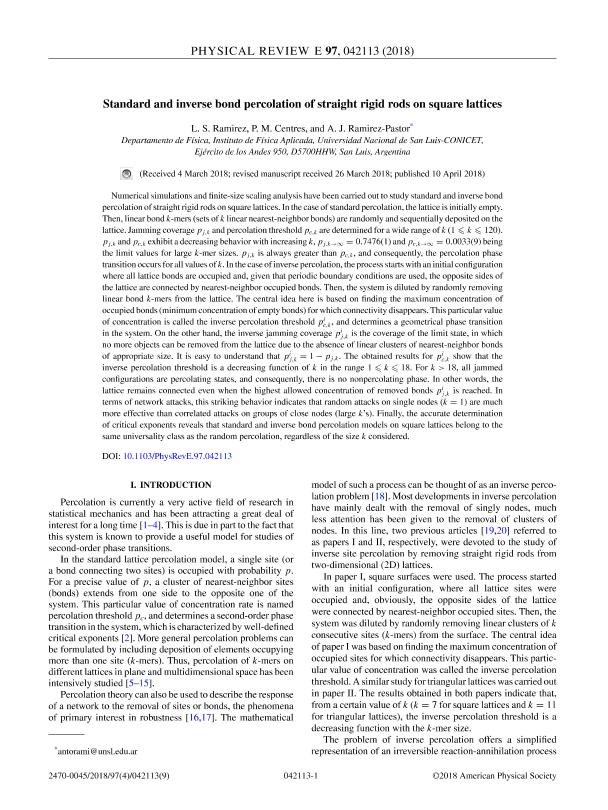Artículo
Standard and inverse bond percolation of straight rigid rods on square lattices
Fecha de publicación:
04/2018
Editorial:
American Physical Society
Revista:
Physical Review E: Statistical, Nonlinear and Soft Matter Physics
ISSN:
1539-3755
e-ISSN:
2470-0053
Idioma:
Inglés
Tipo de recurso:
Artículo publicado
Clasificación temática:
Resumen
Numerical simulations and finite-size scaling analysis have been carried out to study standard and inverse bond percolation of straight rigid rods on square lattices. In the case of standard percolation, the lattice is initially empty. Then, linear bond k-mers (sets of k linear nearest-neighbor bonds) are randomly and sequentially deposited on the lattice. Jamming coverage pj,k and percolation threshold pc,k are determined for a wide range of k (1≤k≤120). pj,k and pc,k exhibit a decreasing behavior with increasing k, pj,k→∞=0.7476(1) and pc,k→∞=0.0033(9) being the limit values for large k-mer sizes. pj,k is always greater than pc,k, and consequently, the percolation phase transition occurs for all values of k. In the case of inverse percolation, the process starts with an initial configuration where all lattice bonds are occupied and, given that periodic boundary conditions are used, the opposite sides of the lattice are connected by nearest-neighbor occupied bonds. Then, the system is diluted by randomly removing linear bond k-mers from the lattice. The central idea here is based on finding the maximum concentration of occupied bonds (minimum concentration of empty bonds) for which connectivity disappears. This particular value of concentration is called the inverse percolation threshold pc,ki, and determines a geometrical phase transition in the system. On the other hand, the inverse jamming coverage pj,ki is the coverage of the limit state, in which no more objects can be removed from the lattice due to the absence of linear clusters of nearest-neighbor bonds of appropriate size. It is easy to understand that pj,ki=1-pj,k. The obtained results for pc,ki show that the inverse percolation threshold is a decreasing function of k in the range 1≤k≤18. For k>18, all jammed configurations are percolating states, and consequently, there is no nonpercolating phase. In other words, the lattice remains connected even when the highest allowed concentration of removed bonds pj,ki is reached. In terms of network attacks, this striking behavior indicates that random attacks on single nodes (k=1) are much more effective than correlated attacks on groups of close nodes (large k's). Finally, the accurate determination of critical exponents reveals that standard and inverse bond percolation models on square lattices belong to the same universality class as the random percolation, regardless of the size k considered.
Palabras clave:
INVERSE
,
PERCOLATION
,
THRESHOLD
,
JAMMING
,
PERCOLATION
Archivos asociados
Licencia
Identificadores
Colecciones
Articulos(CCT - SAN LUIS)
Articulos de CTRO.CIENTIFICO TECNOL.CONICET - SAN LUIS
Articulos de CTRO.CIENTIFICO TECNOL.CONICET - SAN LUIS
Articulos(INFAP)
Articulos de INST. DE FISICA APLICADA "DR. JORGE ANDRES ZGRABLICH"
Articulos de INST. DE FISICA APLICADA "DR. JORGE ANDRES ZGRABLICH"
Citación
Ramírez, Lucía Soledad; Centres, Paulo Marcelo; Ramirez Pastor, Antonio Jose; Standard and inverse bond percolation of straight rigid rods on square lattices; American Physical Society; Physical Review E: Statistical, Nonlinear and Soft Matter Physics; 97; 4; 4-2018; 42113-42122
Compartir
Altmétricas




